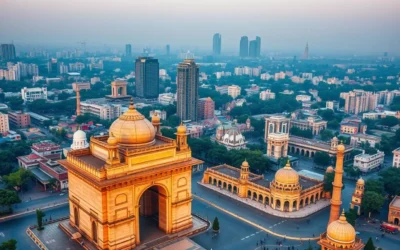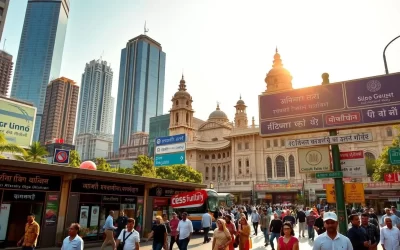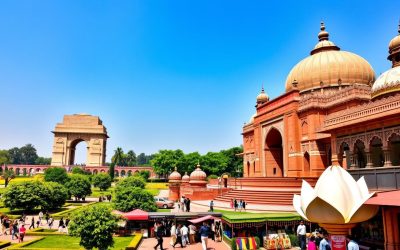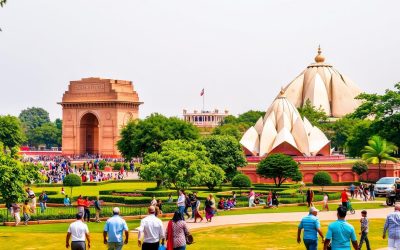✓ Accommodations✓ Flights✓ Rental Cars
India is a land of diverse cultural traditions, where festivals play a vital role in the lives of its 1.2 billion inhabitants. The country’s vibrant celebrations are a reflection of its rich cultural heritage.
The National Capital Territory is a melting pot of diverse cultural celebrations, offering visitors an authentic glimpse into India’s rich festival traditions. Timing your visit around these festivals can transform your experience from ordinary sightseeing to immersive cultural participation.
From religious ceremonies to culinary specialties, music, dance, and community celebrations, each festival in the region showcases different aspects of Indian traditions. Understanding the significance behind these festivals will enrich your travel experience and provide deeper insights into the local way of life.
The Cultural Tapestry of Delhi’s Festival Scene
As the national capital, Delhi is a melting pot of cultures, making it a hub for diverse festivals and celebrations that reflect the rich heritage of the country. The city’s unique position allows it to bring together various regional festivities, creating a vibrant cultural mosaic that is unparalleled.
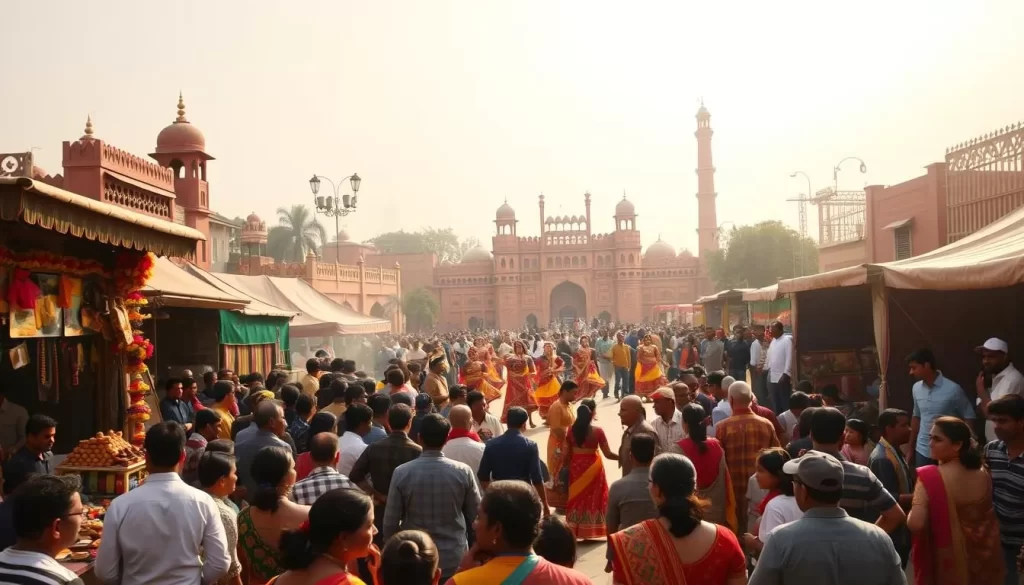
Why Delhi Is India’s Festival Hub
Delhi stands out as India’s festival hub due to its historical significance and cultural diversity. As the seat of numerous empires, the city has a rich celebration heritage that blends Hindu, Muslim, Sikh, and other cultural traditions. This diversity is further enriched by the influx of people from different parts of the country, who bring their regional celebrations to the capital, making it a microcosm of India’s cultural life.
The city’s festival scene is particularly vibrant because it attracts both traditional local celebrations and national commemorations. This makes Delhi an ideal location to experience festivals from different parts of India in one place, giving visitors a unique taste of the region‘s cultural diversity throughout the year.
Best Times to Visit for Festival Experiences
The best time to visit Delhi for festival experiences is during specific periods of the year. October through November is ideal for witnessing Diwali, Durga Puja, and Dussehra, while February through March is perfect for Holi and spring festivals. Each season in Delhi offers different celebrations, from colorful spring festivities to light-filled autumn festivals and patriotic winter commemorations.
Planning your visit around these festival times allows you to participate in community celebrations that might otherwise be difficult to access in other parts of the country. Whether you’re looking to experience the joy of festival celebrations or simply soak in the cultural atmosphere, Delhi has something to offer throughout the year.
Diwali: The Festival of Lights
Diwali, the festival of lights, is a spectacle that transforms Delhi into a vibrant celebration of light and joy. Celebrated across the country, Diwali marks the return of Lord Rama after a 14-year exile, symbolizing the triumph of good over evil.
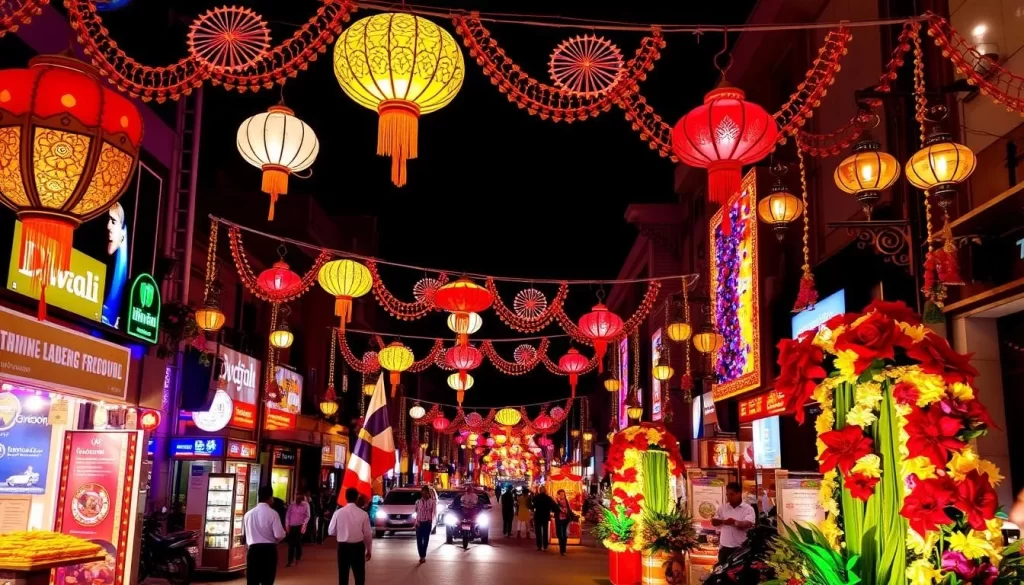
When and How It’s Celebrated in Delhi
Diwali celebrations in Delhi begin days before the main festival with thorough cleaning and decorating of homes and businesses. The city is adorned with rangoli, flowers, and thousands of diyas (clay lamps), creating a mesmerizing ambiance.
The festivities include family pooja, bursting crackers at night, and exchanging sweets with friends and family. The capital’s markets, such as Chandni Chowk and Lajpat Nagar, become vibrant with shopping experiences for decorations, new clothes, and gifts.
Best Places to Experience Diwali in the Capital
The best places to experience Diwali in Delhi include the illuminated markets of Old Delhi, grand celebrations at the India Gate area, and community celebrations in residential colonies. These locations offer a glimpse into local traditions and the festive spirit.
Traditional Foods and Customs
Traditional Diwali foods in Delhi feature an array of sweets like kaju katli and gulab jamun, along with savory snacks that families exchange as gifts. The festival also includes customs like Lakshmi Puja, worshiping the goddess of wealth, observed at temples throughout the city.
While fireworks have been a part of Diwali, recent environmental regulations have led to a focus on eco-friendly celebrations and light displays.
Holi: The Vibrant Festival of Colors
The Holi festival, celebrated on the full moon day in the month of Phalgun (usually March), transforms Delhi into a riot of colors and joyous celebrations that break down social barriers.
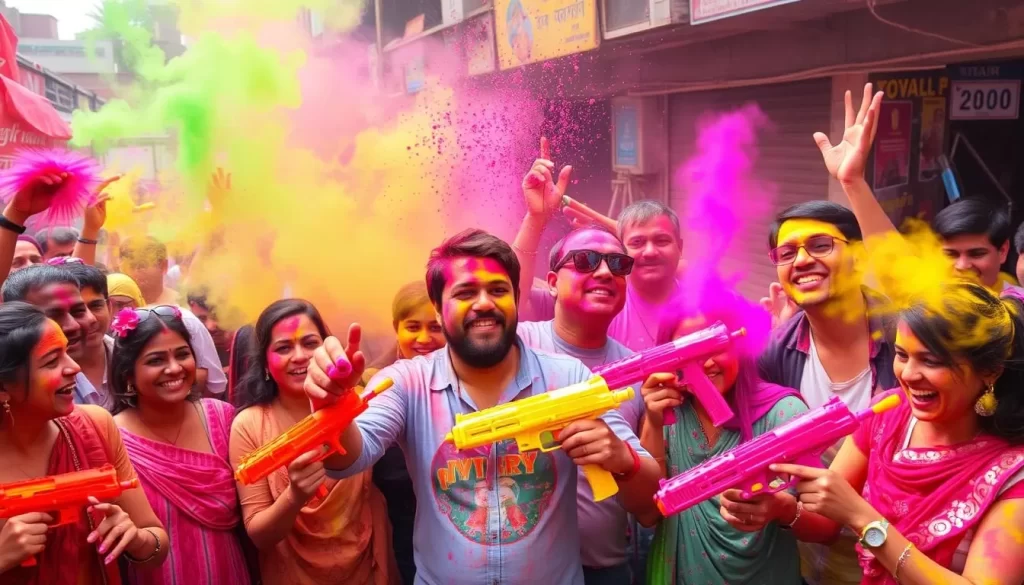
Delhi’s unique Holi celebrations blend traditional rituals with modern festivities, beginning with Holika Dahan (bonfire) the night before, symbolizing the triumph of good over evil.
Delhi’s Unique Holi Celebrations
The main day of the festival sees people of all ages taking to the streets with colored powders (gulal) and water guns (pichkaris), dousing friends and strangers alike in a carnival-like atmosphere that’s particularly vibrant in Old Delhi neighborhoods.
The festival is enjoyed with gusto across the country, but especially in north India, making it a significant experience for visitors.
Safety Tips for Foreign Visitors
For foreign visitors, safety is paramount during Holi – stick to organized events, wear clothes you don’t mind getting permanently colored, protect your skin with oil, and keep valuables (especially cameras and phones) in waterproof cases.
It’s also advisable to be cautious of areas where people might be consuming bhang (a traditional cannabis-infused drink), and women travelers should consider attending organized events rather than street celebrations.
Must-Visit Holi Events in the Capital
Must-visit Holi events in Delhi include the famous celebration at Hari Mandir in Connaught Place, the cultural Holi at Dilli Haat, and various five-star hotels that organize safe, family-friendly Holi parties with traditional food and music.
The Holi Moo Festival (formerly Holi Cow) is Delhi’s largest organized Holi event featuring music, dance, and organic colors in a controlled environment that’s particularly popular with expatriates and tourists.
Durga Puja: Bengali Influence in the Capital
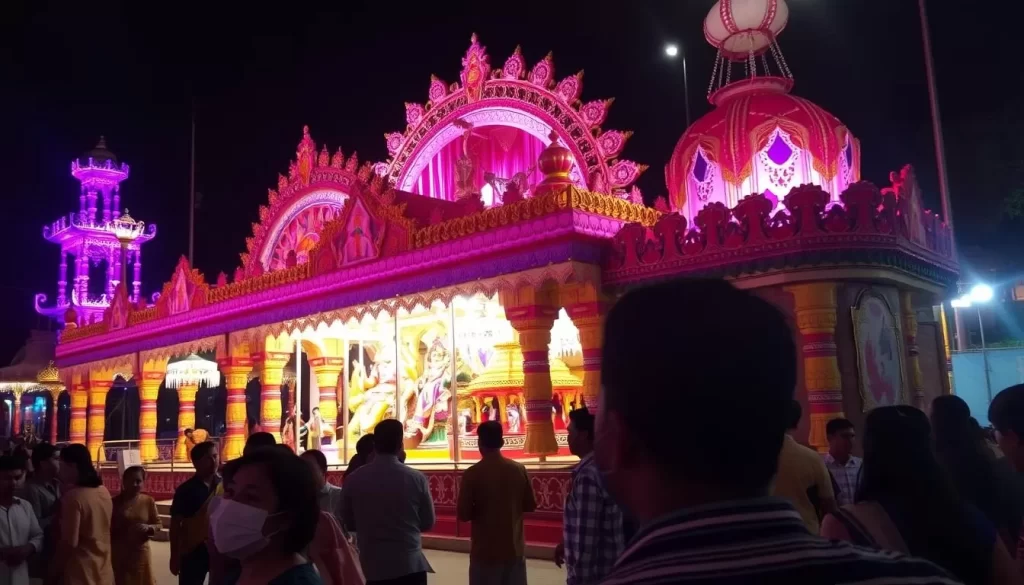
As you explore Delhi during the Durga Puja season, you’ll discover the city’s rich Bengali heritage. The festival, primarily associated with West Bengal, has become a significant part of Delhi’s cultural calendar due to its substantial Bengali population.
CR Park and Other Bengali Hubs
CR Park, often referred to as “Mini Bengal,” is the epicenter of Durga Puja celebrations in Delhi. This area is home to numerous pandals housing elaborate Durga idols that attract thousands of visitors. Other notable Bengali hubs in Delhi, such as Kashmere Gate and Mayur Vihar, also host significant Durga Puja celebrations.
These areas are known for their vibrant cultural programs, including classical dance performances, Bengali folk music, and theatrical performances that showcase Bengali cultural heritage.
Cultural Programs and Food Festivals
The five-day celebration is filled with various rituals and cultural events. From Shashthi to Dashami, each day has its unique significance, with the most vibrant celebrations occurring on Ashtami and Navami.
Food is an integral part of the festival, with special stalls serving authentic Bengali cuisine like fish fry, kosha mangsho, and sweet delicacies such as sandesh and rosogolla. The evenings are particularly special, with illuminated pandals, cultural programs in full swing, and a festive atmosphere that’s hard to miss.
Dussehra: Celebrating the Triumph of Good Over Evil
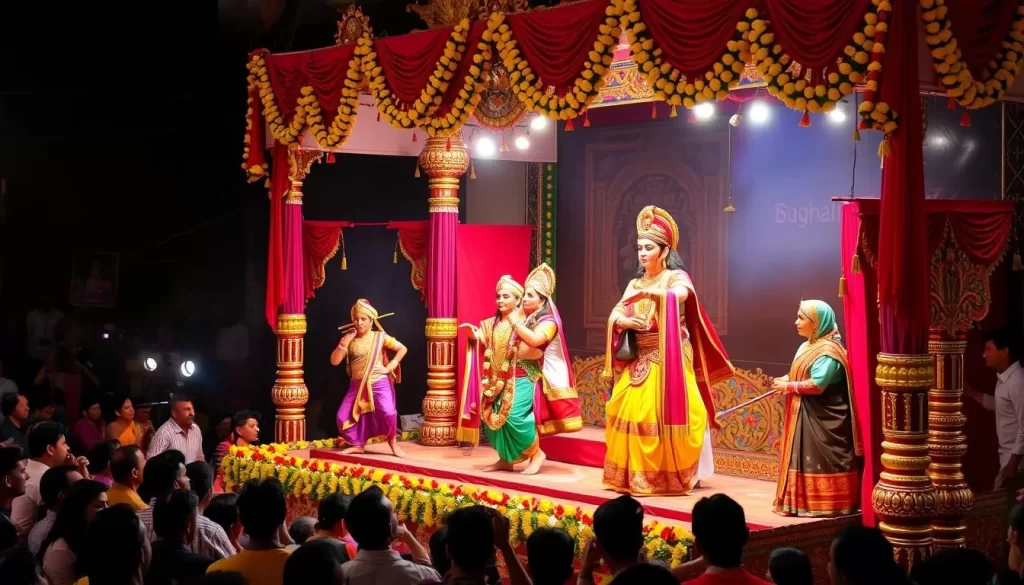
Experience the vibrant Dussehra celebrations in Delhi, a spectacle that embodies the victory of good over evil. Dussehra, also known as Vijayadashami, is celebrated with great enthusiasm across the city, marking the triumph of Lord Rama over the demon king Ravana.
The Dussehra festival is preceded by Ramlila, a dramatic reenactment of the Ramayana epic, performed across Delhi for nine days leading up to Dussehra. The most famous performances take place at the Red Fort grounds, Ramlila Maidan, and Lal Qila Maidan, featuring elaborate costumes and traditional music.
Famous Ramlila Performances
Delhi’s Ramlila tradition dates back centuries, with some performances being over 180 years old. The Ramlila at Ramlila Maidan is particularly notable, sometimes featuring Bollywood actors in key roles. These performances are a significant part of Delhi’s cultural heritage, attracting large audiences.
Ravan Dahan Ceremonies Across Delhi
The culmination of the festival is Ravan Dahan, where massive effigies of Ravana, his brother Kumbhakarna, and son Meghnad are ceremoniously burned. Some of the most impressive Ravan Dahan ceremonies take place at the Ramlila grounds near Red Fort, Dwarka, and Noida border, drawing thousands of spectators. This spectacle symbolizes the triumph of good over evil, a theme that resonates with people across the country.
For visitors, Dussehra offers a unique opportunity to witness living mythology and understand the cultural significance of the Ramayana in contemporary Indian life. The celebration is a testament to the rich cultural diversity and heritage of Delhi, making it a memorable experience for those who witness it.
Navratri and Dandiya Nights
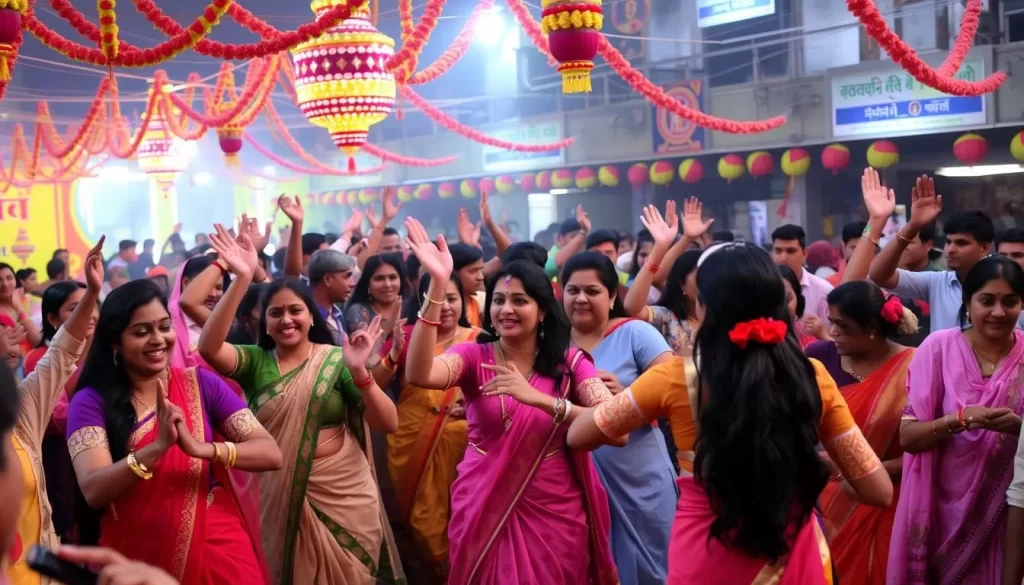
The festival of Navratri brings a burst of energy to Delhi, with people from all walks of life coming together to dance and celebrate. Navratri, a nine-night festival dedicated to Goddess Durga, transforms the city into a whirlwind of dance and devotion, particularly showcasing the Gujarati cultural influence in the capital.
While Navratri has religious significance with many devotees fasting and performing prayers, the festival’s most visible aspect in Delhi is the vibrant Garba and Dandiya Raas dance celebrations that take place across the city. The celebration is a testament to the city’s rich cultural diversity.
Popular Venues for Garba and Dandiya
Delhi offers numerous venues for Garba and Dandiya enthusiasts. Popular spots include the Gujarati Samaj in Civil Lines, various DDA grounds in Pitampura and Rohini, and numerous five-star hotels that organize ticketed Dandiya nights with live music and professional performers.
These venues attract a large crowd, creating an electric atmosphere that is hard to miss during the festival season. Many of these events take place over the nine days of Navratri, offering multiple opportunities to experience the vibrant culture.
Traditional Attire and Dance Styles
Traditional attire is a highlight of Navratri celebrations, with women wearing chaniya choli (embroidered skirts and blouses) with mirror work and men dressed in kediya (pleated tops) and dhoti, all in vibrant colors that add to the visual spectacle.
The Garba dance involves women moving in concentric circles around an image or statue of Goddess Durga, while Dandiya Raas features dancers striking sticks (dandiyas) in rhythmic patterns, both accompanied by traditional folk songs and modern remixes. This blend of tradition and modernity makes Navratri a unique festival experience in Delhi.
Eid Celebrations in Old Delhi
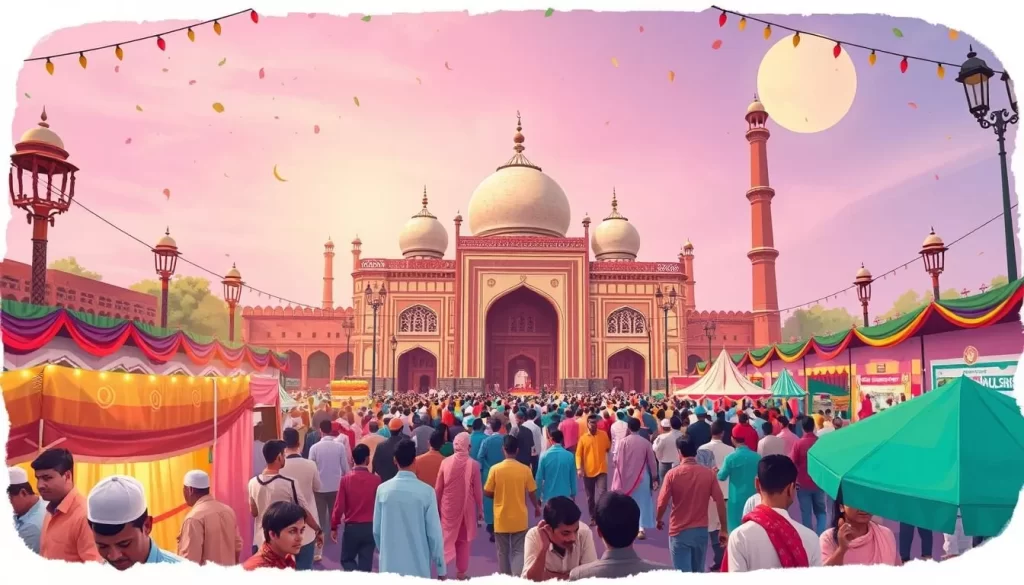
The spirit of Eid is palpable in Old Delhi, where the streets come alive with prayers, festivities, and delectable cuisine. Eid-Ul-Fitr marks the end of Ramadan, the Muslim holy month of fasting, and is celebrated with great fervor.
Eid celebrations in Old Delhi offer visitors one of the most authentic and vibrant cultural experiences in the National Capital Territory. The historic Jama Masjid becomes the focal point of Eid celebrations, with thousands of devotees gathering for special morning prayers.
Jama Masjid and Chandni Chowk Festivities
The Jama Masjid, India’s largest mosque, is a sight to behold during Eid, with devotees spilling out into the courtyard and surrounding streets. Chandni Chowk transforms into a festive hub, with shops decorated with lights and special Eid bazaars selling everything from clothes to decorations.
For visitors, the best time to experience Eid in Old Delhi is after the morning prayers when families emerge in their finest clothes, exchanging greetings of “Eid Mubarak.” The streets come alive with celebrations that continue well into the night.
Culinary Delights During Eid
The culinary experience during Eid in Old Delhi is unparalleled, with legendary eateries in Matia Mahal and Chitli Qabar serving special Eid delicacies. Must-try specialties include sheer khurma, biryani, nihari, and seviyaan, all prepared according to traditional recipes.
Many restaurants and food stalls stay open late into the night during Eid, offering special menus that attract food enthusiasts from across the city. Establishments like Karim’s and Al Jawahar are particularly popular for their Eid offerings.
National Capital Territory, India: Top Festivals to Check Out When Visiting Throughout the Year
Throughout the year, the National Capital Territory of India hosts a wide array of festivals that reflect the country’s rich cultural heritage. This diversity makes the capital an exciting destination for travelers interested in experiencing the vibrant cultural tapestry of India.
Spring Festivals
Spring in Delhi, from February to April, is a time of joy and celebration. You can experience Holi, the colorful festival of colors, Mahashivratri, dedicated to Lord Shiva with all-night temple vigils, and Baisakhi, the Punjabi harvest festival featuring bhangra dancing and community feasts. Additionally, spring brings Buddha Purnima celebrations at Delhi’s Buddhist temples and Gudi Padwa, the Maharashtrian New Year, celebrated with special processions and traditional foods.
Summer Celebrations
Summer in Delhi, from May to July, is characterized by intense heat, but the city still manages to host various celebrations. You can witness Eid al-Adha with grand celebrations in Old Delhi, Teej, celebrating the monsoon, and Raksha Bandhan, honoring the brother-sister relationship. The summer season also features mango festivals and cultural events that take place indoors or in the evenings.
Autumn and Winter Festivities
Autumn and winter bring a plethora of festivals to Delhi. Autumn festivities, from August to October, include Janmashtami, Ganesh Chaturthi, Navratri, Durga Puja, Dussehra, and culminating in Diwali, the festival of lights. Winter, from November to January, brings Guru Nanak Jayanti, Christmas celebrations, Lohri bonfires, and Republic Day celebrations, along with various cultural and food festivals.
| Season | Festivals/Celebrations | Months |
|---|---|---|
| Spring | Holi, Mahashivratri, Baisakhi, Buddha Purnima, Gudi Padwa | February-April |
| Summer | Eid al-Adha, Teej, Raksha Bandhan, Mango Festivals | May-July |
| Autumn | Janmashtami, Ganesh Chaturthi, Navratri, Durga Puja, Dussehra, Diwali | August-October |
| Winter | Guru Nanak Jayanti, Christmas, Lohri, Republic Day | November-January |
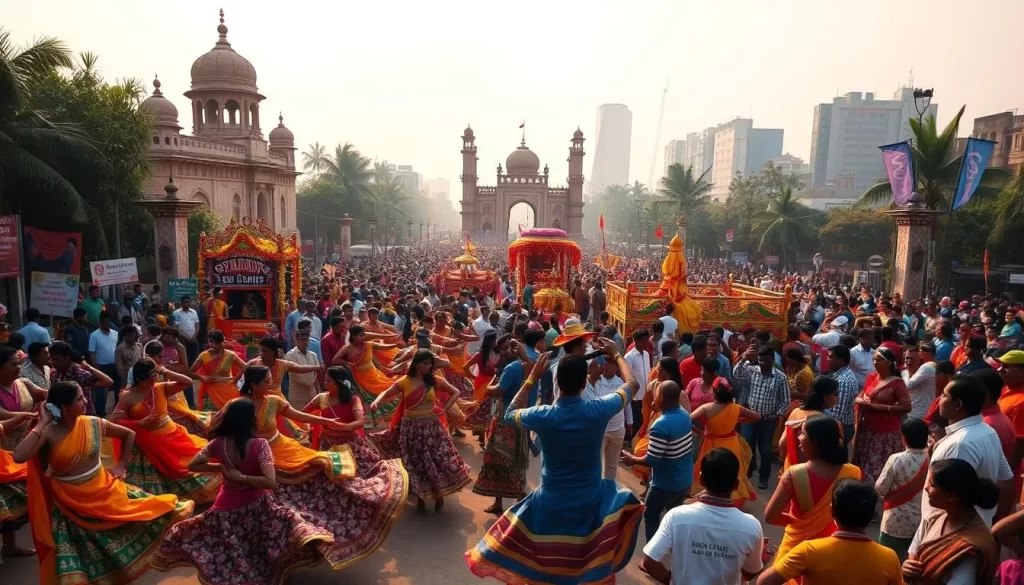
Republic Day Parade: A Patriotic Spectacle
Experience the patriotic fervor of India’s Republic Day Parade in Delhi, a spectacle that showcases the nation’s military prowess and cultural diversity.
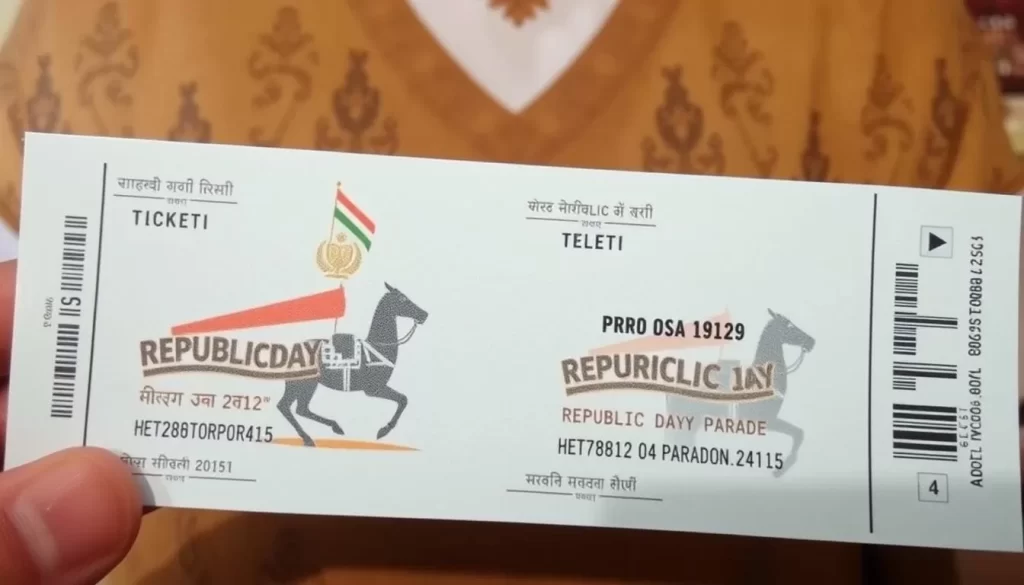
The Republic Day Parade, held on January 26th each year, is a grand celebration that commemorates the adoption of India’s constitution in 1950. It’s a day when the country comes together to celebrate its transition to an independent republic.
Rajpath Celebrations and Military Display
The main event takes place on Rajpath (now officially renamed Kartavya Path), where contingents from all three military services, paramilitary forces, and police units march in perfect synchronization before the President of India. The military display includes showcases of India’s latest weaponry, tanks, missile systems, and fighter jet flyovers, demonstrating the country’s defense capabilities.
The parade also features cultural tableaux from different states of India, presenting elaborate moving displays of their traditions, historical achievements, and cultural heritage. This grand display is a testament to India’s rich cultural diversity and national unity.
How to Secure Tickets and Best Viewing Spots
Securing tickets for the Republic Day parade requires planning, as they’re limited and in high demand. Tickets can be purchased online through the Ministry of Defence website starting in early January, or through various government offices and tourism bureaus.
For those unable to secure official seating, good viewing spots include areas along Janpath where the parade passes after the main ceremony. It’s advisable to arrive very early (by 6 AM) to secure a spot. Additionally, don’t miss the “Beating the Retreat” ceremony held on January 29th at Vijay Chowk, featuring military bands and a spectacular light show that concludes the Republic Day celebrations.
Lohri: Welcoming the Harvest Season
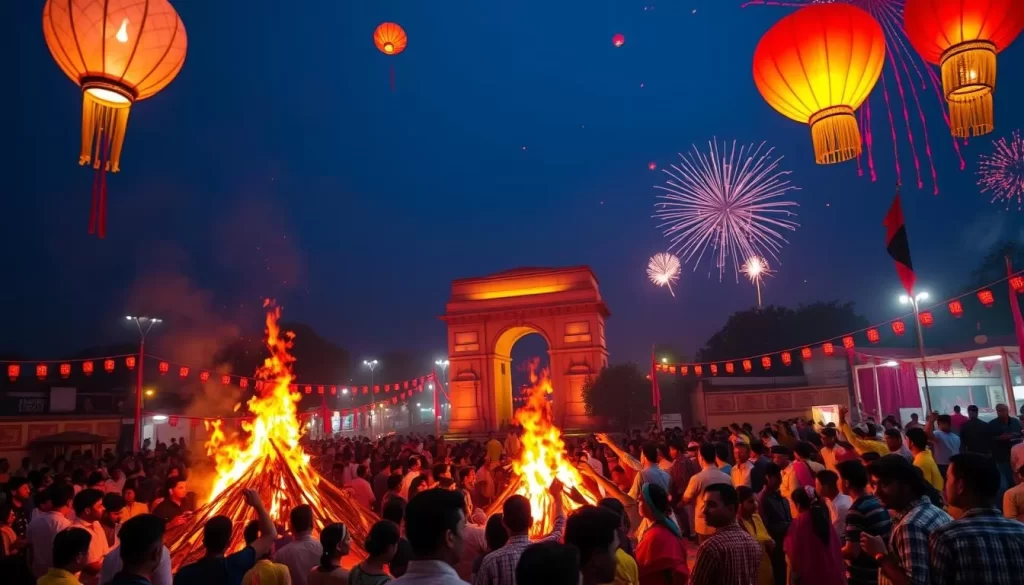
As the winter chill begins to fade, Delhi comes alive with the vibrant celebrations of Lohri, a festival that marks the beginning of the harvest season. Celebrated primarily in the Punjab region, Lohri has become an integral part of Delhi’s cultural fabric, thanks to the significant Punjabi influence in the city.
Lohri is observed on January 13th each year and is a joyous celebration that signifies the end of winter and the onset of longer days. It’s a time when people come together, light bonfires, dance, and feast on traditional foods, embodying the spirit of community and the joy of harvest.
Community Bonfires and Traditional Songs
The centerpiece of Lohri celebrations is the community bonfire, representing the fire god Agni. People gather around these bonfires, throwing sesame seeds, jaggery, and popcorn into the flames while chanting “Aadar aye dilather jaye” (may honor come and poverty vanish). Traditional Lohri songs, such as “Sunder mundriye,” tell the story of Dulla Bhatti, a Robin Hood-like figure from Punjab, adding a historical dimension to the celebrations.
Punjabi Influence on Delhi’s Lohri
The Punjabi influence on Delhi’s Lohri celebrations is evident in the grand scale of festivities in neighborhoods like Punjabi Bagh, Rajouri Garden, and Lajpat Nagar. Community associations organize large gatherings with professional bhangra and gidda performances, showcasing the rich cultural heritage of Punjab. For visitors, Lohri offers a unique opportunity to experience Punjabi hospitality, with special foods like makki di roti and sarson da saag being prepared specifically for this festival.
Delhi’s Lohri celebrations have evolved to include modern elements like DJ music alongside traditional folk songs, creating a unique blend of ancient harvest traditions and contemporary celebration styles. Whether you’re a local or a visitor, Lohri in Delhi is an experience that embodies the warmth and vibrancy of Indian festival culture.
Ganesh Chaturthi: Celebrating Lord Ganesha
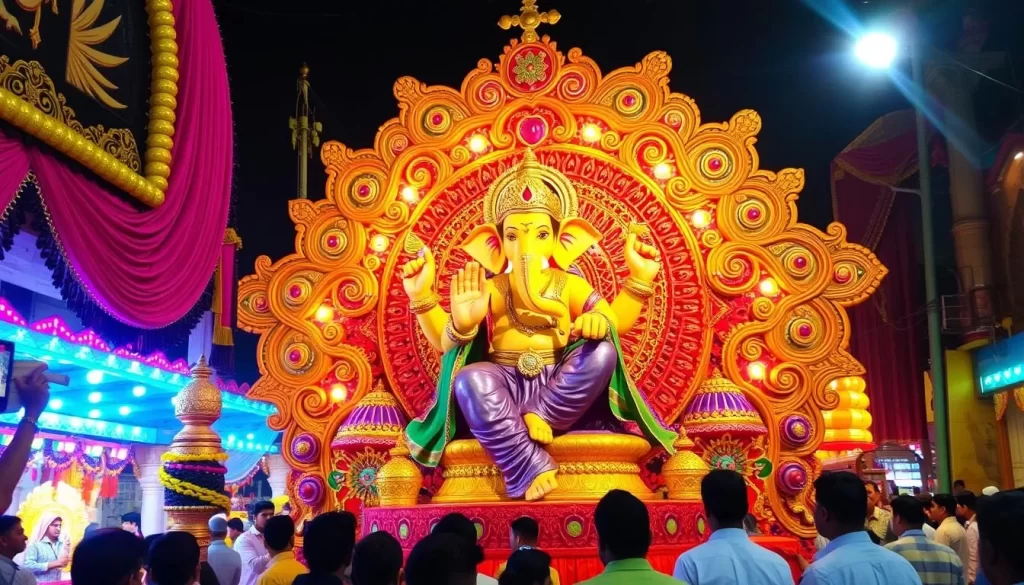
Delhi is experiencing a surge in the popularity of Ganesh Chaturthi, a festival honoring Lord Ganesha. This celebration marks the birthday of the elephant-headed deity and is observed with great enthusiasm across the country.
The festival begins with the installation of clay Ganesha idols in homes and public pandals, followed by 10 days of prayers and community celebrations. On the final day, the idols are immersed in water bodies in a ceremony known as visarjan.
Notable Ganesh Pandals in Delhi
Some of the notable Ganesh pandals in Delhi include the Laxmi Nagar Ganesh Pandal, known for its themed decorations, the CR Park pandal, influenced by Bengali aesthetics, and the Karol Bagh pandal, famous for its elaborate arrangements.
Visarjan Processions and Celebrations
The visarjan processions are a highlight of the festival, with devotees carrying Ganesha idols to designated immersion sites, chanting and dancing along the way. The processions feature people coming together, creating a vibrant atmosphere.
Christmas in the Capital
Christmas in Delhi is a unique experience, merging colonial heritage with modern-day cheer. As you explore the city during this festive season, you’ll discover that Christmas has evolved into a major cultural festival that transcends religious boundaries.
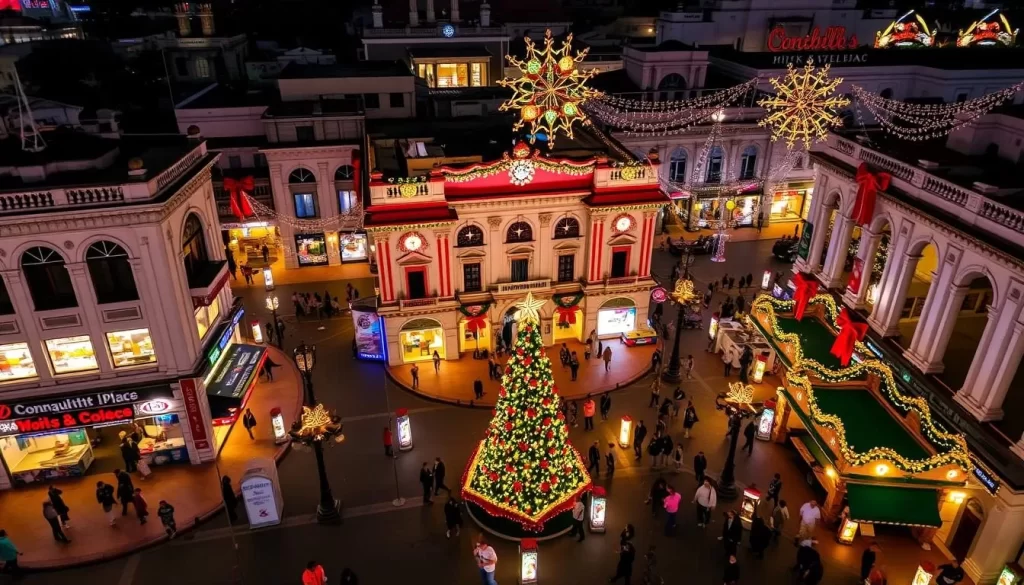
Connaught Place and Cathedral Church Festivities
Connaught Place, Delhi’s colonial-era commercial hub, transforms during Christmas with elaborate decorations and light displays, creating a festive atmosphere reminiscent of European Christmas markets. The Sacred Heart Cathedral and St. James’ Church become focal points for midnight mass services, attracting both Christians and visitors from other faiths.
The Christmas Eve programs at Delhi’s churches are open to the public, featuring carol singing and community feasts that provide insight into Christian traditions in the Indian context.
Christmas Markets and Special Events
Christmas markets have become increasingly popular in Delhi, with special bazaars at Select Citywalk and Dilli Haat offering international Christmas foods, decorations, and gifts. Hotels across the capital compete to create impressive Christmas decorations and special events, including lavish Christmas brunches and visits from Santa Claus.
The Christmas season seamlessly transitions into New Year celebrations, creating a festive period that extends for about two weeks and offers multiple opportunities to experience Delhi’s cosmopolitan character.
Krishna Janmashtami: Celebrating Lord Krishna’s Birth
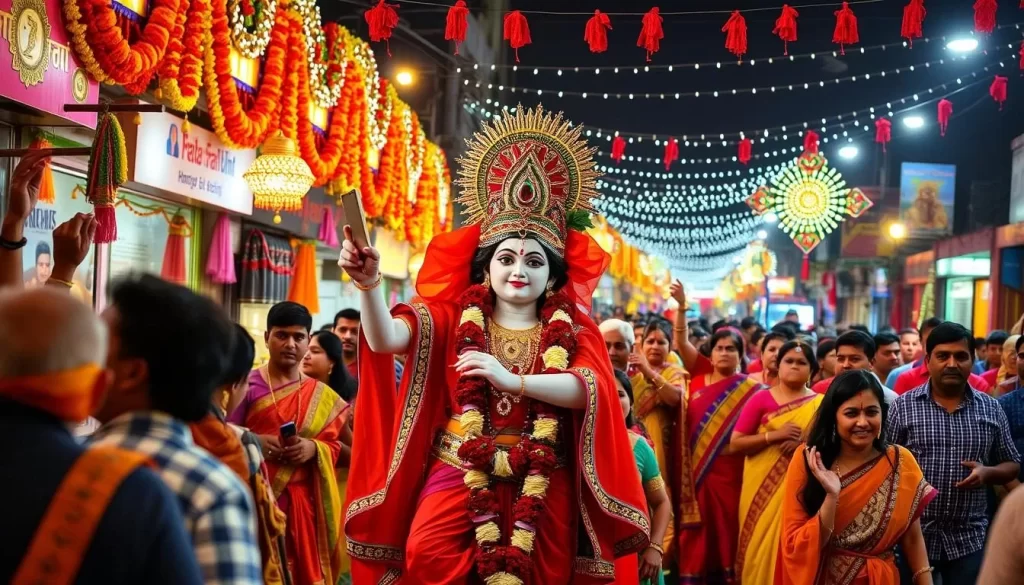
Delhi comes alive with the vibrant celebrations of Krishna Janmashtami, honoring the birth of Lord Krishna. This festival is a significant event in the city, marked by devotion and fervor. People fast throughout the day, visiting temples and participating in midnight prayers and bhajan singing as part of the celebration.
The ISKCON Temple in East of Kailash is a major hub for Janmashtami celebrations in Delhi. It hosts round-the-clock bhajans, dance-drama performances depicting Krishna’s life, and a grand feast at midnight to commemorate Krishna’s birth.
ISKCON Temple Celebrations
The ISKCON Temple decorates its main shrine elaborately with flowers, lights, and themed displays, attracting thousands of devotees. Many observe a full-day fast, breaking it after the midnight celebration of Krishna’s birth, with special prasad distributed at temples throughout the city.
Dahi Handi Competitions
Dahi Handi competitions are a highlight of Janmashtami, recreating Krishna’s childhood mischief. Young men form human pyramids to break a pot of curd suspended high above the ground. These events take place in areas like Dwarka and Rohini, drawing large crowds and creating a festive atmosphere.
For visitors, Janmashtami offers a unique opportunity to experience Hindu devotion and community celebrations, reflecting Krishna’s joyful persona. The festival is a testament to the rich cultural heritage of India and the country’s diverse festivals, including those celebrated in festivals india.
Planning Your Festival Visit to Delhi
To make the most of your visit to Delhi during the festivals, advance planning is crucial to navigate the crowds and make the most of your experience. Delhi’s festival calendar is rich with diverse celebrations that showcase the city’s cultural heritage.
Accommodation Tips During Festival Seasons
When visiting Delhi during major festival celebrations, it’s advisable to book your accommodations well in advance. Popular areas like Connaught Place, Karol Bagh, and Paharganj are convenient bases for exploring the city’s festival events. Consider staying in neighborhoods that are relevant to the specific celebration you’re interested in, such as CR Park for Durga Puja or Old Delhi for Eid celebrations, to minimize travel time.
Many hotels in Delhi offer special festival packages that include guided experiences and traditional meals, providing a more immersive experience for visitors. Booking at least 2-3 months in advance is recommended for popular festivals like Diwali and Holi.
Transportation and Crowd Management
Transportation during festivals can be challenging due to traffic closures and crowded public transportation. The Delhi Metro is the most reliable option, although it can be crowded. For events involving processions or large gatherings, consider hiring a private driver for the day or using ride-sharing apps to navigate around congested areas.
Effective crowd management is essential during Delhi’s festivals. Wear comfortable shoes, carry minimal belongings, stay hydrated, and visit major sites early in the morning or later in the evening to avoid peak crowds. Researching specific festival etiquette before attending is also recommended to show respect for local traditions.

Conclusion: Embracing Delhi’s Festival Culture
Delhi’s festival scene is a kaleidoscope of colors, sounds, and emotions that capture the essence of India’s cultural identity. As you immerse yourself in the city’s vibrant festival culture, you’ll discover that it’s not just about celebrations; it’s a reflection of the country’s diversity, integrity, and unity.
By participating in Delhi’s diverse festivals, you’re becoming part of a living tradition that has evolved over thousands of years. Each festival reveals different aspects of Indian life, from religious devotion to seasonal changes and family bonds. The festivals in India showcase the country’s rich cultural heritage, encouraging social connections and a deeper understanding of its people.
The festival calendar of Delhi is filled with celebrations like Diwali, Holi, Durga Puja, and Republic Day, each offering a unique experience. Whether you’re drawn to the colors of Holi or the lights of Diwali, Delhi’s festival culture has something to offer every visitor. As you plan your visit, consider timing it around one of these festivals to transform your experience into a profound cultural immersion.
In conclusion, Delhi’s festivals are a testament to the country’s pluralistic society, where different cultures and traditions coexist. By embracing this festival culture, you’ll not only witness cultural events but become a part of India’s living heritage. So, come and experience the magic of Delhi’s festivals and create memories that will last a lifetime.
The above is subject to change.
Check back often to TRAVEL.COM for the latest travel tips and deals.

